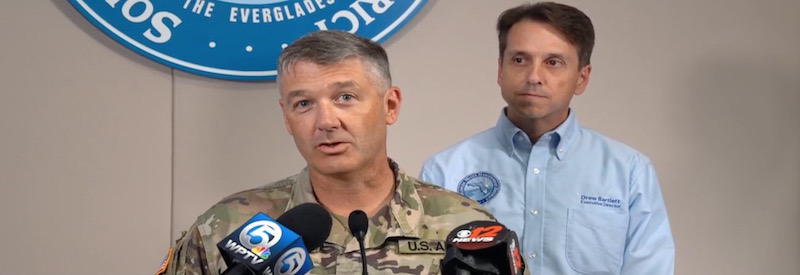New Precedent Established in Florida’s Fight For Clean Water
New Precedent Established in Florida’s Fight For Clean Water
Plan for the worst and hope for the best is a philosophy that hasn’t always figured into Florida water management. But why not?
As recent events have shown, we become more capable of lending greater security to human health and safety and our environment when we prepare for worst-case scenarios. This new line of thinking has us on the brink of an amazing shift in water policy–and that could change everything about how we manage water.

Recent operational management by the U.S. Army Corps of Engineers and the South Florida Water Management District displays exactly the kind of prioritized thinking that Bullsugar supporters and Floridians impacted by toxic discharges have advocated and hoped for.
Before a change in Hurricane Dorian’s track ultimately spared Florida’s east coast, early predictions called for significant rainfall that had Floridians bracing for a rapid rise in Lake Okeechobee and post-storm impacts reminiscent of Hurricane Irma. If the history of Irma-related events serves as any indication of probable outcome, the likelihood that this summer’s reprieve from toxic discharges would continue seemed doubtful.
A few things contributed to a much more positive outcome for us.
- One of them was was pure chance. At some point, the capacity of any system can be overcome by more water than it can handle. The aftermath of Dorian could have been very different for us if not for the devastating stall over the Bahamas followed by a shift north that resulted in much less rainfall than anticipated in our own system. We were lucky, but we were also ready.
- Lake Okeechobee levels pre-Dorian were already much lower than this time in years past, thanks largely to operational changes championed by Congressman Brian Mast reflected in the PROTECT Florida Act, making pre-storm releases unnecessary.
- Following the storm, the Army Corps and SFWMD hosted a joint press conference where they discussed operational changes including holding more water north of the lake to prevent lake levels from rising too quickly, thereby ensuring the stability of the Herbert Hoover Dike, and maximizing releases of clean water south from the lake to avoid harmful discharges to the St. Lucie and Caloosahatchee.
This is the actualization of worst-case scenario management like we’ve never seen before. A year ago, human health implications from toxic algae discharges weren’t something that the Army Corps considered. Now state and federal water managers are factoring in the risk of toxic blooms and making decisions together to ensure that harmful releases to the estuaries are no longer a first option, but rather a last resort.
“We’re going to continue to do this,” SFWMD Executive Director Drew Bartlet said during the press conference, “continue to meet daily and look for opportunities to help manage lake levels so we can avoid harmful discharges in the future.”
This is big news–a sea change in Florida water management. Game-changing input from the Army Corps’ Colonel Andrew Kelly and SFWMD strengthens support for the ability to manage water for the safety of all Floridians, right now, without destroying the northern estuaries, by changing operations of the 1948 Central and Southern Florida project.
This revelation wouldn’t be possible without the dogged advocacy of elected officials like Brian Mast who insisted on lowering the lake to protect human health. It probably wouldn’t have happened without Gov. DeSantis’ demand for the resignation of the entire sitting SFWMD governing board early this year–a move that incited a fresh start for the public agency which had strayed in purpose and intent. And it couldn’t have happened without Bullsugar supporters who told their stories, who “voted water,” and who refused to give up on short-term solutions that complement the years of infrastructure and funding that we still need.
The fight isn’t over, but this is the beginning of a new era. Together, we will succeed in taking back our water.


